The Garibaldi Fish, also known as the golden Garibaldi or California Garibaldi, is a bright orange-colored saltwater fish found only in Southern California.
Garibaldi Fish is best suited for experienced fish keepers and not for beginners, as they require a large tank which can be difficult for a non-experienced person to maintain.
The garibaldi fish is the official marine state fish of California. They are protected in California, and collecting or keeping them without a permit is illegal. However, these Fish are scarce in the North of California.
This article will cover everything you need to know about keeping Garibaldi Fish, including tank size, water conditions, feeding, breeding, etc.
Keeping a garibaldi is not for everyone, but we will help you understand these creatures better and how you should keep them at home. We hope you learn about these Fish and have them in your aquarium. So let us jump right into it.
Table of Contents
- Garibaldi Fish: Species Specification
- Garibaldi Fish: Behavior & Temperament
- Garibaldi Fish: Food & Diet
- Garibaldi Fish: Care
- Garibaldi Fish: Tank Size
- Garibaldi Fish: Water Parameters
- Garibaldi Fish: Water Changes
- Garibaldi Fish: Cleaning the Tank
- Water Conditioners & Water Test Kits
- Lighting & Heating Requirements
- Filtration
- Substrate & Gravel
- Plants & Other Decorations
- Ammonia & Nitrates Level
- Protein Skimmer & Gravel Vacuum
- Transportation and Handling
- Garibaldi Fish: Compatibility & Tank Mates
- Garibaldi Fish: Fish To Avoid
- Garibaldi Fish: Assimilation
- Garibaldi Fish: How To Determine The Sex Of Fish
- Garibaldi Fish: Reproduction
- Garibaldi Fish: Potential Diseases
- Garibaldi Fish: Treatment & Medication
- Advantages Of Having Garibaldi Fish In Your Tank
- Disadvantages Of Having Garibaldi Fish In Your Tank
- Conclusion
Garibaldi Fish: Species Specification
| Scientific name: | Hypsypops rubicundus |
| Common names: | Golden garibaldi, California garibaldi, Catalina goldfish, and marine goldfish |
| Family: | Pomacanthidae |
| Size: | 15 inches |
| Average Life span: | 17 - 25 years |
| Water temperature: | 68° to 79° Fahrenheit. |
| pH Level: | 8.1 to 8.4 |
| Temperament: | Semi-aggressive |
| Care level: | Moderate/Intermediate |
| Diet: | Omnivore |
| Coloration: | Bright orange |
| Minimum tank size: | 100 gallons |
| Tank set up: | Live rock with plenty of hiding places |
| Compatibility: | Other large semi-aggressive Fish, such as tangs and large angels. Must not be kept with same species |
The garibaldi fish may be perfect if you want a bright and colorful addition to your saltwater aquarium. They are relatively peaceful but can become aggressive toward other Fish if threatened.
When selecting a garibaldi fish, look for one brightly colored and has no visible defects or injuries. Avoid any fish that appear to be sick. Buying your Fish from a reputable dealer is always best to ensure you get healthy Fish.
Why Are They Called Garibaldi Fish?
The garibaldi fish is named after the Italian political hero Giuseppe Garibaldi, famous for helping unite Italy in the 1840s. He often wore a red shirt and died a national hero after fighting for the reunification of Italy.
Garibaldi Fish: Appearance
Garibaldis have a large head and mouth with small teeth. Their bodies are oval-shaped, and they have long tail fins. Garibaldis are beautiful but unique-looking Fish that will stand out in your aquarium. They are bright orange, with orange or yellow fins.
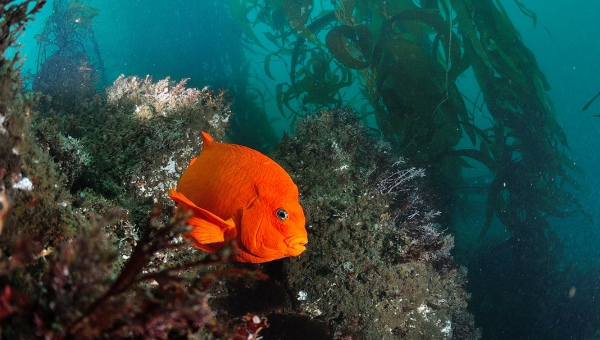
Their eyes and mouth are on the top of their heads, allowing them to see and feed even with a current in the water. Their eyes are yellow, and their mouth is small with a single row of teeth.
Young Garibaldis are red-orange with blue spots on their body, dorsal and caudal fins, and some faint blue margins. The older they get, the fewer spots they have.
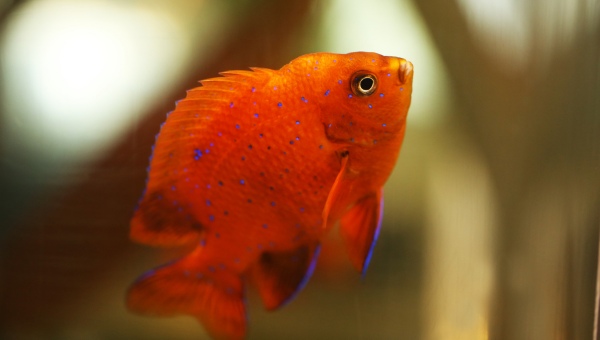
Also Read: Crowntail Betta Species Profile & Care Guide: 2023 Updated |
Garibaldi Fish: Size & Lifespan
Garibaldis can grow up to 15 inches long, although the males are usually more significant than the females. Garibaldi can live in captivity for 17 to 25 years, although they may only live for ten or fewer in the wild. The typical weight of Garibaldi is between 1 to 3 pounds.
Also Read: Odessa Barb Care 101: Species Profile, Care, Diet & All 2023
Garibaldi Fish: Origin & Distribution
Garibaldis are found only in the waters of Southern California. They are the natives of the Eastern Pacific Ocean and inhabit the subtropical waters of southern California and Baja California's west coast.
They are scarce in Northern California and are protected by law in California and Mexico. They are native to the kelp forests of this region. Australia, Japan, and Hawaii are other countries where you may find Garibaldis.
Also Read: Honey Gourami (Sunset Honey Gourami) Care Guide 101 | 2023
Garibaldi Fish: Habitat
Garibaldis are found in kelp forests and reefs in the waters. They prefer areas with lots of hiding places and plenty of live rock. Garibaldis are found in depths of up to 33 feet to tolerate a wide range of water conditions and temperatures.
Also Read: Monte Carlo plant (Micranthemum tweediei) Growth, Size |2023
Garibaldi Fish: Behavior & Temperament
Garibaldi Fish is known for being semi-aggressive, especially towards other species of Fish that they consider a threat. They are best kept with similar predatory Fish, such as large tangs and angels.
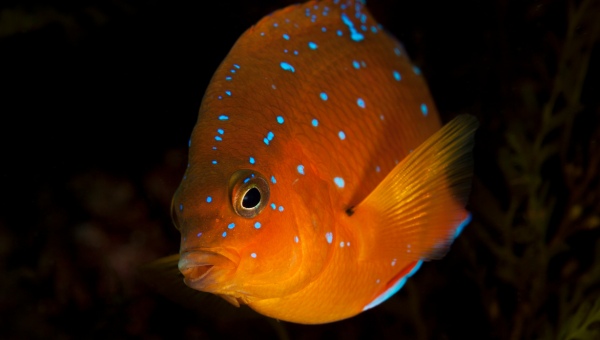
Because they have sharp spines on their fins, it is essential to approach them carefully and avoid making sudden movements that could startle them. However, they can make exciting and beautiful additions to your tank with careful handling and a well-maintained aquarium environment.
Also Read Rosy Barb 101: Care, Species, Appearance, Tankmates, Habitat & All |
Garibaldi Fish: Food & Diet
Garibaldi Fish is omnivorous and eats other animals and plants, but they mostly graze on anemones, sponges, and algae that grow on rocky places.
Garibaldi Fish: Diet in the Wild
Garibaldis are typically found in shallow coastal waters along Southern California, where they can be seen feeding on plankton and micro-organisms near kelp forests.
They are excellent cleaners and will often clean other Fish in the wild. Finding food in the wild is not a problem for these Fish, but they may need to be fed more often in captivity.
Garibaldi Fish: Diet in Captivity
Garibaldis should be fed a diet of live foods in captivity, such as brine shrimp, Mysis shrimp, and krill. They should also be given a variety of frozen foods, such as squid, clam, and mussels.
It is important to vary their diet to ensure that they get all the necessary nutrients. They will also consume algae from your tank as they are not fussy eaters.
Garibaldi Fish: Feeding Frequency
Garibaldis should be fed 2 to 3 times per day. They should be given small meals to consume within a few minutes. It is important not to overfeed them, leading to health problems.
They are large Fish, and feeding them more can make them bloated, leading to many other problems.
Garibaldi Fish: Different Feeding Methods
There are a few different ways that you can feed your Garibaldi fish.
The options are explained below:
- Feeding by hand: This is the best way to control how much your Fish are eating. It also helps to build a bond between you and your Fish.
- Use a feeding ring: This is a great way to ensure your Fish get the same food each time. It also helps to prevent too much food from accumulating in the aquarium.
- Feeding tubes: You can also use a feeding tube to ensure your Fish get the right food without overfeeding them.
Garibaldi Fish: Care
Garibaldi Fish is moderately cared for and needs specific tank size requirements, water conditions, and various decorations.
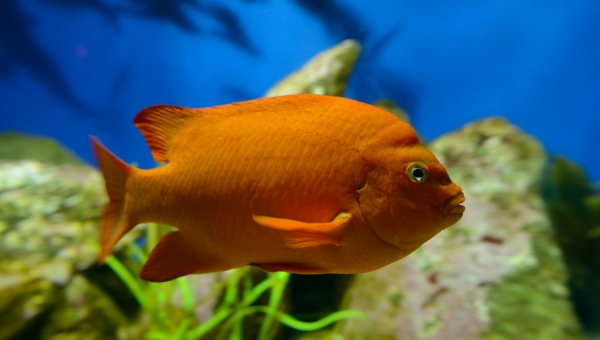
Garibaldis do best in an aquarium with lots of live rock, giving them lots of hiding places and making it easier to hunt for food.
They also require strong water currents, so you should place your powerheads or wavemakers strategically to create the proper flow in your tank.
Garibaldi Fish: Tank Size
Garibaldis need a tank of at least 100 gallons in size with plenty of live rock to provide them with hiding places. A larger tank would be even better, giving your Fish more room to swim and grow.
The optimal dimensions for a Garibaldi aquarium are 24 x 36 inches, although you can get away with smaller dimensions if you have a larger tank.
But we recommend getting a larger tank as it suits the Fish. These are the specifications for a single fish. If you want more than one Fish, you will need to increase the size of your tank.
Garibaldi Fish: Water Parameters
Garibaldis are saltwater Fish, so you must maintain the correct water parameters in your aquarium. The specific gravity should be between 1.020 and 1.025, and the pH should be between 8.1 to 8.4. The water temperature should be between 68° to 79° Fahrenheit.
Garibaldi Fish: Water Changes
It is essential to do regular water changes to maintain the correct water parameters. We recommend that you do a 10% water change every two weeks. This is important to help keep your Fish healthy and happy and their ecosystem safe.
Garibaldi Fish: Cleaning the Tank
You will also need to clean the tank regularly. This includes vacuuming the gravel, cleaning the glass, and wiping down any buildup surfaces. We recommend that you do this at least once a week.
Cleaning the tank, in particular, is easy, but it is essential to be aware of how much you are cleaning your tank so that you don't disturb the balance. This can cause a sudden surge in algae and other organisms, which aren't harmful but may not be welcomed by your Fish.
Water Conditioners & Water Test Kits
To help keep your water clean and healthy, you may also want to use a water conditioner in your tank. This will remove harmful chemicals or compounds in the water, helping create a healthier environment for your Fish.
To ensure that your tank is in good health, it is also essential to test the water regularly. You can do this using water test kits available at most pet stores. This will allow you to monitor your tank's pH and other important parameters to make necessary adjustments.
Lighting & Heating Requirements
Garibaldis require a temperature between 68° to 79° Fahrenheit, so you must use a heater to maintain the correct temperature in your aquarium. We also suggest keeping a thermometer in your aquarium to check the temperature.
Garibaldis need light for 12 to 14 hours each day. You can use aquarium light or natural sunlight if your tank is in a brightly lit room.
If the temperature fluctuates too much in your tank, it can cause stress and health issues for your Fish, so it's essential to keep on top of these various factors and maintain the correct environment.
Filtration
Garibaldis are somewhat messy Fish, so you need to ensure a sound filtration system is in place. This will help keep your tank clean and healthy, but it also helps prevent any buildup of waste or food in the water. We recommend using an external filter for maximum efficiency.
Substrate & Gravel
In addition to strong water currents, Garibaldis also need substrates and gravel free from sharp edges or other defects. This makes feeding more accessible and gives them a softer surface to swim around. We recommend using smooth, fine-grained gravel in your aquarium.
Plants & Other Decorations
Finally, Garibaldis enjoy having some hiding places in their tanks. You can do this by adding various decorations and plants to your tank. Good options include live rock, large rocks, driftwood, and artificial plants.
Just make sure that any decorations or plants you choose are safe for placing in a saltwater aquarium and that they don't have any sharp edges that could harm your Fish.
Ammonia & Nitrates Level
Your tank's ammonia and nitrate levels should be kept low, as these can cause health problems for your Garibaldis. You can do this by ensuring that you are feeding them high-quality food and keeping up with regular water changes.
The ammonia level must not exceed 0.5 ppm, and the nitrate level should not exceed 20 ppm.
Protein Skimmer & Gravel Vacuum
Finally, it is important to regularly use a protein skimmer and gravel vacuum in your tank. This will help remove any excess food or waste from the water, further helping to maintain the health of your Fish. These Fish can be messy, and these devices can look after their mess much more accessible.
Transportation and Handling
Using a secure fish net or box for moving them is essential to ensure that your Garibaldis are safe during transportation and handling.
Handling them gently and carefully is essential, as avoiding sudden movements or loud noises could startle them. If you are concerned about their well-being during transport, you may want to ask a professional for assistance.
Also Read: Kribensis Cichlid Care Guide 101: Size, Diet & More| 2023
Garibaldi Fish: Compatibility & Tank Mates
Due to their predatory nature, Garibaldi fish are best kept with other large, semi-aggressive Fish, such as tangs and wrasses.
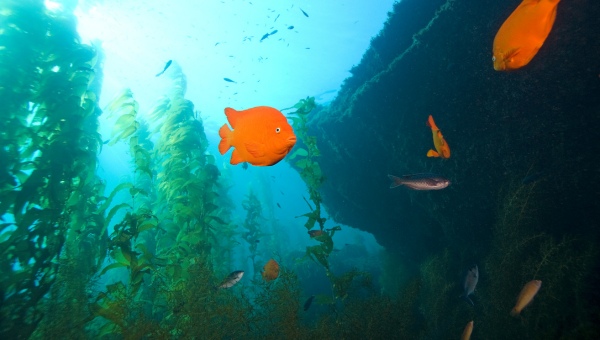
They should not be kept with the same species or any smaller or more docile fish species to avoid fights and injuries.
Species you can keep with Garibaldi Fish:
- Groupers
- Tangs
- Large Angels
- Large Wrasses
- Soapfish
- Starfish
- Bristle Worms
- Lionfish
- Damselfish
Garibaldi Fish: Fish To Avoid
Fish that should be avoided as tank mates for Garibaldi Fish include:
Garibaldi Fish: Assimilation
Once you have selected a healthy garibaldi fish, it is important to slowly acclimate them to your aquarium. These Fish are susceptible to changes in water conditions and temperature, so taking your time when acclimating them is essential.
We recommend using the drip method, which slowly adds water from your aquarium to the Fish's transport container over an hour or more. This will allow them to adjust slowly and avoid any shocks that could be harmful.
After they have been acclimated, you can add them to your tank. It is best to add them at night, as this will give them time to adjust to their new surroundings and find a hiding place before other Fish see them in the tank.
Also Read: Giant Betta Fish Care Guide 101: Look, Size, & More | 2023
Garibaldi Fish: How To Determine The Sex Of Fish
Determining the sex of Garibaldi Fish is not easy as there is very little difference between males and females. The best way to determine the sex of your Fish is to wait until they are fully grown and then look for physical differences in their appearance.
Males tend to be slightly larger than females and have more pointed fins. Females also tend to have a rounder body shape, and their fins are not as pointed.
However, these differences can be very subtle, and it is often hard to distinguish between males and females without careful observation.
Also Read: Sailfin Pleco Care 101: Diet, Size, & More | 2023 Updated |
Garibaldi Fish: Reproduction
Garibaldi Fish reproduce by laying eggs on the surface of rocks or coral. The male fertilizes the eggs and is left to hatch on their own. Once they have hatched, the fry (baby fish) are on their own and must fend for themselves.
Garibaldi fry is tiny and cannot compete with other Fish for food, so it is essential to provide plenty of hiding places in your aquarium where they can find shelter and get the nutrients they need to grow.
If you are interested in breeding Garibaldi Fish, setting up an appropriate tank environment to support this process is essential. This typically involves maintaining a stable water temperature, pH level, and oxygen content in the tank.
You may also need to perform frequent water changes and feed them a nutritious diet that supports healthy growth and development. You can successfully breed Garibaldi fish with careful attention to these details and enjoy watching this fascinating process unfold.
Also Read: Jack Dempsey Fish Care 101: Size, Diet Color & More | 2023
Garibaldi Fish: Potential Diseases
Garibaldi Fish are relatively resistant to disease, but there are a few potential problems that you should be aware of. One of the most common diseases affecting these Fish is white spot disease caused by a parasitic worm. This worm burrows into the Fish's skin and causes white spots on its body. If left untreated, it can be fatal to your Fish.
Other diseases like Marine Ich and Marine Velvet can also affect Garibaldi fish. These diseases are caused by parasites that attach to the Fish's skin and gills, causing irritation and inflammation. If left untreated, they can be fatal to your Fish.
Also Read: Rabbit Snail Care Guide 101: Size, Diet, Breed & More | 2023
Garibaldi Fish: Treatment & Medication
Maintaining good water quality and using a quarantine tank for newly introduced Fish is vital to prevent white spot disease. You can also treat your Fish with antiparasitic medications designed to kill the parasite. However, you should consult a veterinarian or specialized aquarium expert to find the proper treatment for your Fish.
You may need to use medications designed specifically for these conditions to treat other diseases like Marine Ich and Marine Velvet. These medications contain chemicals that can kill parasites or inhibit their reproduction ability.
Always follow the instructions provided by your vet or aquarium expert when using medications, and be sure to remove any carbon from your filter while the treatment is taking place.
Also Read: 10 Most Popular Types Of Angelfish: Appearance, Size & All |
Advantages Of Having Garibaldi Fish In Your Tank
- The Garibaldi is a California State Fish and the second most popular Marine Aquarium fish globally.
- They are orange with spots and have beautiful blue circles around their eyes. As they grow, they tend to get more orange and look prettier.
- Garibaldi is very hardy and can live in captivity for 25 years.
- They do best in a fish-only or reef tank with plenty of hiding places.
- The Garibaldi is a voracious eater and will eat almost anything you put in the tank, making them easy to care for.
Disadvantages Of Having Garibaldi Fish In Your Tank
- The Garibaldi is a semi-aggressive fish and may bully smaller Fish or ornamental invertebrates.
- They have been known to eat small crabs, shrimp, and other invertebrates.
- The Garibaldi is also known to be jumpers, so make sure your aquarium is covered.
Conclusion
The Garibaldi is a beautiful and popular fish that is relatively easy to care for. However, they are semi-aggressive and may bully smaller Fish or invertebrates. They are also jumpers, so it is essential to keep your aquarium covered. Your Garibaldi fish can live a long and happy life with proper care.
We hope you will consider adding a Garibaldi to your tank and experience all of the benefits that it has to offer. We hope this article has helped you understand this Fish's care to thrive. We tried our best to deliver the answers you have sought about Garibaldis. We expect this article will make you happy. Thanks for reading!



